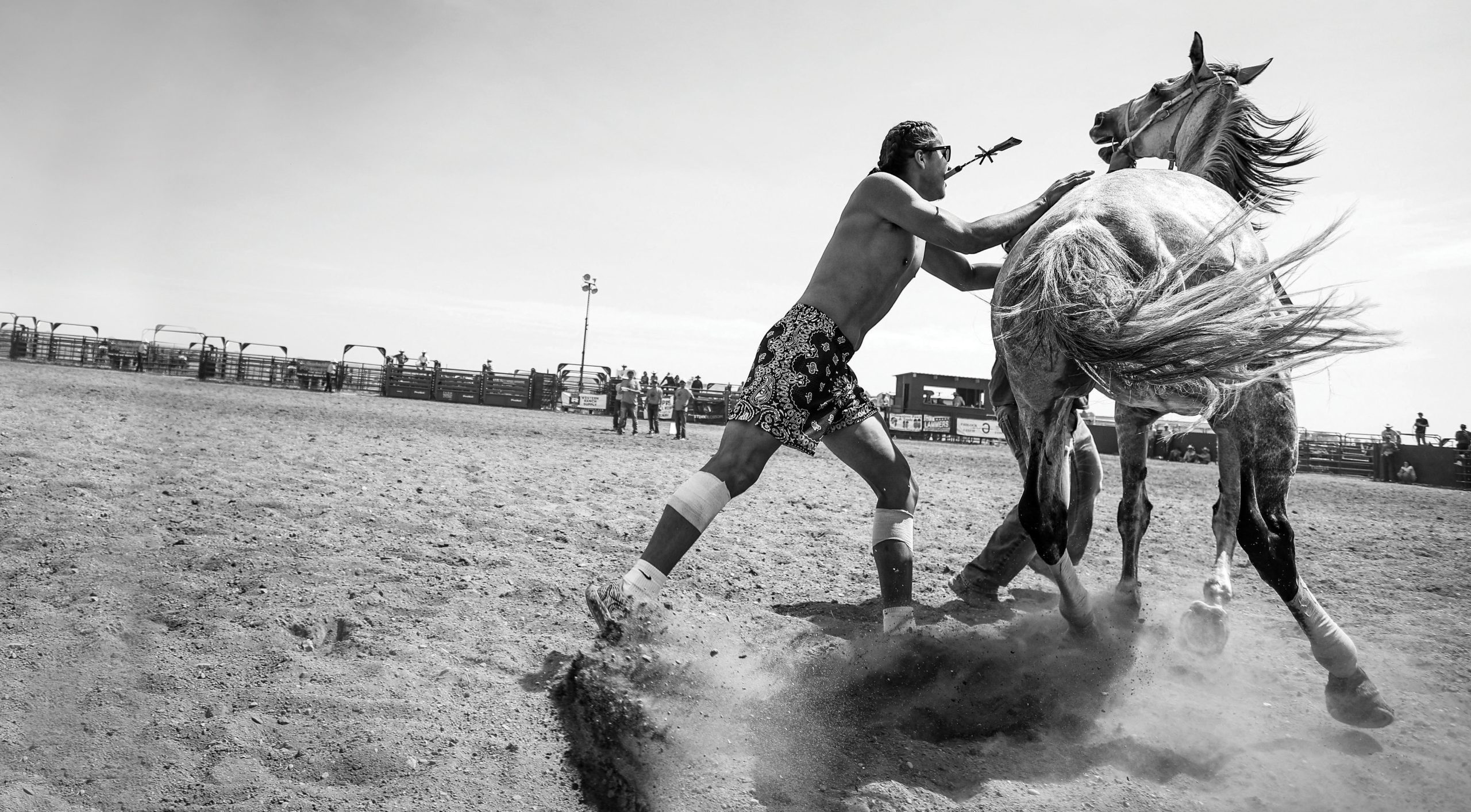
29 May Warriors on Horseback
Thundering hooves, clouds of dust, whipping manes and tails, and breathtaking skill — Indian relay is one of the earliest extreme sports. Born from Great Plains tribal traditions, these relays test courage, athleticism, teamwork, and horsemanship. From the stands, Indigenous spectators speak a variety of languages, whooping war cries as they cheer for their tribes, many of which have come from far reaches of the continent to compete.

There’s no distinct line at the start — it’s a large chaotic starting zone. At the sound of the fog horn Iron Eyes women’s relay team member Heaven Brady’s horse leaps forward as Lorraine Goggles releases the horse and claps to get it moving a little faster.
Riding bareback at full gallop on a thoroughbred, the same breed of horse that runs in the Kentucky Derby, a team’s rider acts as the baton. After one lap, the rider leaps off the horse at speeds between 15 and 25 miles per hour into the designated “hole” on the track. A “stopper” then grabs the horse’s reins to help bring it to a halt within a designated exchange area. Stoppers are calm, fearless team members; they don’t flinch when stepping in front of a 1,000-pound thoroughbred running straight toward them. Meanwhile, the rider takes three strides between dismounting one horse and mounting the next, which is held by the “mugger.” The mugger’s job is to position this second horse for a safe mount and clear getaway from the hole without crashing into other horses or participants. The exchange is the sport’s most dangerous and exciting part: Collisions aren’t uncommon.
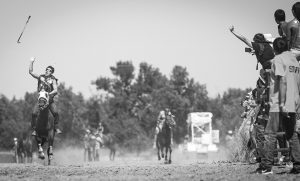
Charging toward victory, the rider tosses his crop high in celebration and somehow manages to catch it at a full gallop. Cheering family members and fans celebrate his giant lead and imminent win moments before he crosses the finish line.
These images were captured at Crow Fair in Crow Agency, Montana — the “Teepee Capital of the World” — during an annual powwow that attracts Indigenous tribes from around the continent. Crow Fair will be held August 15 to 17, with many events and competitions, including rodeos and relays focusing primarily on horsemanship.

One second, the rider is horseback; the next, he’s rolling in the dirt as his horse barrels forward. Relatively unfazed, the rider stood up and walked off the track, defeated but without serious injury.
A male-only sport for over a century, this adrenaline-charged competition now includes women’s teams. Jade Bends, elected by her peers in Crow Agency as the first female rodeo manager for the 105th Annual Crow Fair in 2024, has spent decades reinvigorating interest and commitment to the sport within tribal youth. The healing powers of caring for horses and riding them in nature are important experiences that she wants to pass along to the next generation: It’s one way to help mend the trauma she sees in her community at Crow Agency.

The mugger braces himself as the incoming horse races into the pit. His job: to stop the thoroughbred’s full gallop without getting in the way of his teammate. A successful exchange often determines the winner of the race.
Whitney HoldsTheEnemy, the racing commissioner for Crow Fair in 2024 and 2025, also owns the HoldsTheEnemy men’s relay team. He, like Bends, is creating an opportunity for Crow youth to participate in a family sport that preserves the horse culture of his people while keeping them out of trouble. A third-generation relay racer himself, he took over his father’s team at 16. Today, his team of mostly young men also includes his 22-year-old daughter, Sephra Covers Up.
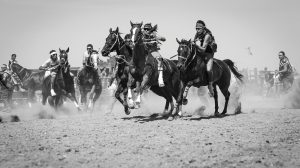
The starting area erupts in mayhem as five teams explode into motion. In the men’s relay, a teammate doesn’t hold the horse at the start. When the horn blows, the rider leaps aboard as his horse simultaneously lunges forward.
Selecting and training horses takes months of work, he explains. In addition to building stamina for a half-mile race, a horse has to be able to quickly and calmly pull into the hole while surrounded by other horses and people. It takes a horse with a unique temperament to excel in this racing sport.
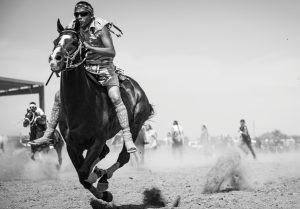
Riding with no saddle or stirrups is deeply rooted in tribal heritage. Jockeys often tape their legs and feet for protection during the high-impact exchanges.
Lorraine Goggles owns and competes on the Iron Eyes women’s relay team. “Indian relays originated as a form of gambling, horse trading, warfare against other tribes, and hunting buffalo,” she explains. Team members must take good care of the horses, cooling them down afterward and tending to their needs. It’s a lot of work that takes time and commitment, but it’s worth it for reasons deeply rooted in Indigenous tradition and identity. Goggles inspires women to compete, knowing that the sport strengthens their mental, emotional, and spiritual health.

At this critical moment in the relay, the rider loses his footing during his dismount but is still able to safely make the exchange. The mugger steps in front of the horse, signaling with his hands to tell the horse to slow down so he can grab the reins and bring it to a sudden stop within the pit.
For many, horses are more than just companions. They are revered as sacred partners with vital spirits. In relay, the athleticism, skill, and speed of the competitors and their horses meld into one, a lasting tribute to the animals and the generations of warriors that rode them.
Melanie Maganias loves capturing the essence of her subject matter in editorial assignments, at weddings, and in portraits by following her intuition and using her camera as a tool to depict her vision. Named one of America’s Top 15 Wedding Photographers by PDN, her work has been featured in The New York Times, Forbes, Real Simple Weddings, Martha Stewart Weddings, and many other publications. She earned bachelor’s and master’s degrees in photography and has also taught at Montana State University.



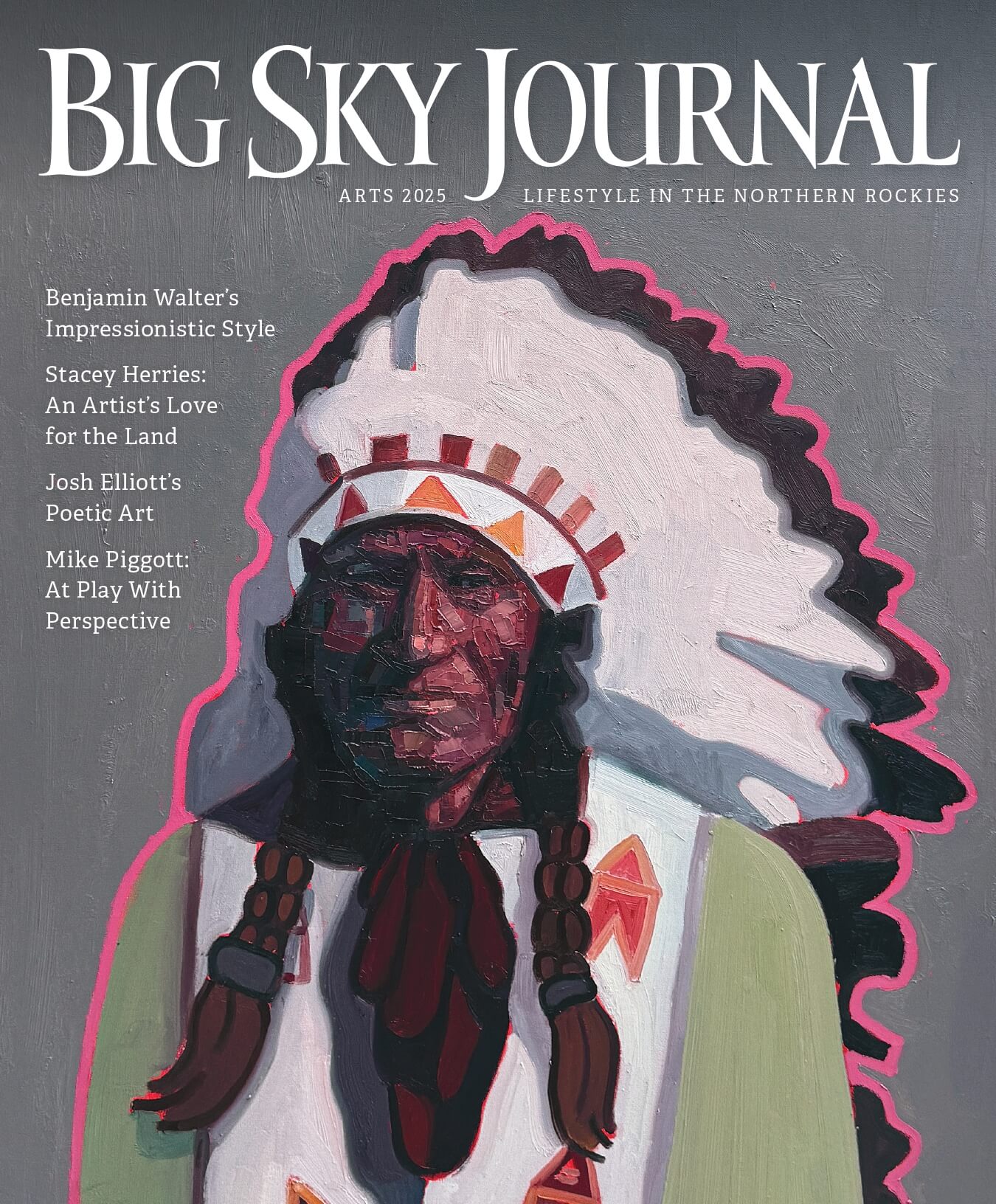
No Comments